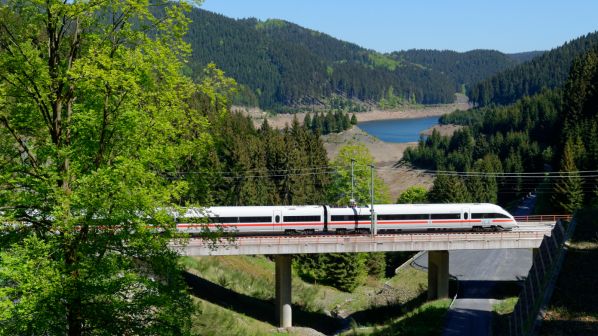The 173-page ‘Strong Rail’ strategy succeeds the previous ‘DB 2020’ strategy and is intended to build on the Better Rail Agenda devised by DB last year with the objective of enhancing quality and punctuality and improving customer satisfaction. DB says ‘Strong Rail’ addresses the transport and climate policy goals of the Federal Government.
“Germany will only achieve its climate goals if it succeeds in massively shifting traffic to rail in the next decade,” says DB CEO Dr Richard Lutz. “Germany needs a strong railway: for the climate, for the people, for the economy and not least for Europe. We are committed to our responsibility in society and will put everything we do on a strong footing.”
DB says the “ambitious” goals set out in ‘Strong Rail’ will only be achieved through close collaboration between the company, the rail industry, and politicians.
The federal government will make its final decisions in the coming months on the LuFV III performance and financing agreement, which will set the framework for DB investment in 2020-2024. “In this context, the gradual digitalisation of the local rail network is just as important as long-term reconstruction and expansion,” DB says.
The strategy is built around 10 core statements:
- Germany’s climate goals can only be achieved with ‘Strong Rail’: Decarbonisation targets can only be met with a significant modal transfer to rail. DB plans to switch all traction energy to 100% renewable sources by 2038, 12 years earlier than previously planned
- ‘Strong Rail’ will focus on the core business: developing a strong rail business in Germany is central to the strategy and its implementation. DB says DB Schenker will be a “real help for DB Cargo in its profitable growth” but “DB Arriva has little strategic relevance for ‘Strong Rail’ and will therefore be sold.”
- Long-distance passenger numbers will double: additional direct services and increased frequencies will help push DB towards its target of 260 million inter-city passengers a year. More than 30 cities will be connected by half-hourly inter-city trains.
- DB will gain a billion passengers in public transport: stronger local passenger transport and integration with other modes will attract more than a billion people a year onto rail and other forms of public transport.
- DB Cargo will carry 70% more freight on German rails: DB Cargo will purchase more than 300 locomotives as part of its drive to increase its share of the rail freight market from 18 to 25%. DB Cargo also wants to attract new business to rail and work with politicians to “establish an economically sustainable single wagonload network.”
- In cooperation with the federal government, DB wants to increase network capacity by 30%: to support the anticipated growth in freight and passenger traffic, DB aims to create capacity for an extra 350 million train-km annually. This will be achieved through expansion, technological innovation and digitalisation, as well as better utilisation of existing capacity.
- Digitalisation will take Germany’s railways into a new age: a “technological quantum leap” will improve capacity, quality, reliability and efficiency.
- Stations will be transformed into modern mobility centres: capacity will be doubled to accommodate 40 million passengers a day, with seamless interchanges between train and bike, bus, and new mobility services such as car sharing and electric scooters.
- DB will hire 100,000 new employees over the next few years: at a time when many large firms are shedding staff, DB will grow its workforce.
- More trains and services than ever before:DB will increase long-distance capacity by up to 100%, increasing the inter-city fleet by 600 vehicles, particularly through investment in high-speed trains. More small and medium-sized cities will be added to the inter-city network and served by a long-distance train at least every two hours. DB will also work with transport authorities to increase the seating capacity of nearly 1000 existing regional vehicles by up to 12%.

